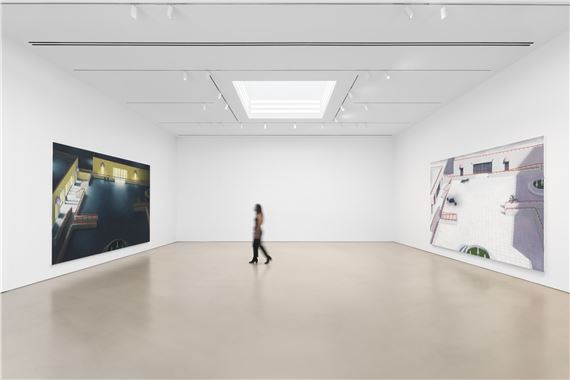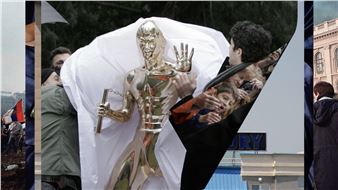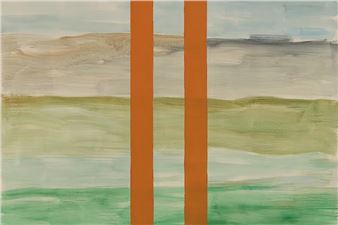Thomas Eggerer: Plaza
We might imagine that the bright red handrails, flat white walls, and the brute emptiness or starkness of the gridded courtyard captured the artist’s attention when encountering the photograph from which Plaza A derives, tropes resonating with his long-standing fascination with the “faded modernism” of the 1970s. Here are visual markers of an architectural modality now so ubiquitous as to undermine temporal and geographical certainties, of a space so banal or ordinary that it also confounds easy understanding of its possible function or modes of occupation. The courtyard could be in Asia, the Middle East, or North America, it might have been built in the late 1970s, or five years ago. It is at once contingent and generic. If we can recognize legacies of architectural gestures at work—like Hans Hollein’s Media Lines for the 1972 Munich Olympics, colorful railings later coursing through James Stirling’s Neue Staatsgalerie Stuttgart of 1984 to become familiar handrails within a commercial vernacular—any shift in register is not cast as a devolution, but mobilized for aesthetic tension. Yet one thing seems clear, at least initially: if Plaza seems haunted by histories of social and collective formations, we are looking into a private enclave, at a private space masquerading as a public one, as suggested in the unstable constellation of awkward ramps, flamingo pink awnings, surveillance cameras, potted plants, trash bags, uniformed staff, and fountains. But lament at the forlorn appearance of this “plaza” is not the artist’s game, the paintings don’t judge in this sense. Rather the site’s ordinariness functions as a gambit through which radical ambiguities and thus potentials come to the fore, uncertainties of use and of disposition that are amplified by Eggerer’s formal gestures and careful visual recalibration as the photograph (found online) is expanded and transposed into a massive painting, Plaza A, and its haunting, darker doppelganger, Plaza B, the latter a more self-contained twin that amplifies the unsettling nature of the first, while harboring its own uncanny qualities.
Eggerer spoke of Plaza as performing an “economy of withdrawal,” and indeed the experience of encountering the paintings might be best characterized as an initial, intellectual recognition of what the paintings depict and reprise—an ordinary courtyard, whose emptiness foregrounds a vast grid, and with it flatness and other modernist conceits—followed by an irreconcilable perceptual undoing or dissolution of spatial and temporal logics. Its irresolvable formal components keep your eyes moving, exposing the viewer to a tense battle with an impossible perspective that incites a type of visual scanning, only to be thrown off balance, again and again, as any markers of certainty withdraw. Plaza, that is, invites and repulses, launching a one-two punch, packed at once with cognitive failure and a visceral disorientation that together call for an open-ness to rethinking what the space might harbor, despite or possibly on account of its banality and refusal to declare a use, its lack of instructions. The functional indeterminacy of the courtyard and its grid channels, in the first instance, a flexible character designed to serve economic goals not social ones, pointing to its affiliations with capital’s privatizing, globalizing mandates. Eggerer does not celebrate this privatization, but mines its inherent vulnerabilities: for such spaces remain open to constant reinvention, to refusal, to what he situates as a mode of queering. The paintings do not offer answers to these difficult tensions they craft, but situate the viewer firmly in their grasp, reminding us that such environments seek to condition our bodies and psyches, but cannot entirely do so.

Recommended for you
We might imagine that the bright red handrails, flat white walls, and the brute emptiness or starkness of the gridded courtyard captured the artist’s attention when encountering the photograph from which Plaza A derives, tropes resonating with his long-standing fascination with the “faded modernism” of the 1970s. Here are visual markers of an architectural modality now so ubiquitous as to undermine temporal and geographical certainties, of a space so banal or ordinary that it also confounds easy understanding of its possible function or modes of occupation. The courtyard could be in Asia, the Middle East, or North America, it might have been built in the late 1970s, or five years ago. It is at once contingent and generic. If we can recognize legacies of architectural gestures at work—like Hans Hollein’s Media Lines for the 1972 Munich Olympics, colorful railings later coursing through James Stirling’s Neue Staatsgalerie Stuttgart of 1984 to become familiar handrails within a commercial vernacular—any shift in register is not cast as a devolution, but mobilized for aesthetic tension. Yet one thing seems clear, at least initially: if Plaza seems haunted by histories of social and collective formations, we are looking into a private enclave, at a private space masquerading as a public one, as suggested in the unstable constellation of awkward ramps, flamingo pink awnings, surveillance cameras, potted plants, trash bags, uniformed staff, and fountains. But lament at the forlorn appearance of this “plaza” is not the artist’s game, the paintings don’t judge in this sense. Rather the site’s ordinariness functions as a gambit through which radical ambiguities and thus potentials come to the fore, uncertainties of use and of disposition that are amplified by Eggerer’s formal gestures and careful visual recalibration as the photograph (found online) is expanded and transposed into a massive painting, Plaza A, and its haunting, darker doppelganger, Plaza B, the latter a more self-contained twin that amplifies the unsettling nature of the first, while harboring its own uncanny qualities.
Eggerer spoke of Plaza as performing an “economy of withdrawal,” and indeed the experience of encountering the paintings might be best characterized as an initial, intellectual recognition of what the paintings depict and reprise—an ordinary courtyard, whose emptiness foregrounds a vast grid, and with it flatness and other modernist conceits—followed by an irreconcilable perceptual undoing or dissolution of spatial and temporal logics. Its irresolvable formal components keep your eyes moving, exposing the viewer to a tense battle with an impossible perspective that incites a type of visual scanning, only to be thrown off balance, again and again, as any markers of certainty withdraw. Plaza, that is, invites and repulses, launching a one-two punch, packed at once with cognitive failure and a visceral disorientation that together call for an open-ness to rethinking what the space might harbor, despite or possibly on account of its banality and refusal to declare a use, its lack of instructions. The functional indeterminacy of the courtyard and its grid channels, in the first instance, a flexible character designed to serve economic goals not social ones, pointing to its affiliations with capital’s privatizing, globalizing mandates. Eggerer does not celebrate this privatization, but mines its inherent vulnerabilities: for such spaces remain open to constant reinvention, to refusal, to what he situates as a mode of queering. The paintings do not offer answers to these difficult tensions they craft, but situate the viewer firmly in their grasp, reminding us that such environments seek to condition our bodies and psyches, but cannot entirely do so.

 ARTISTS
ARTISTS













